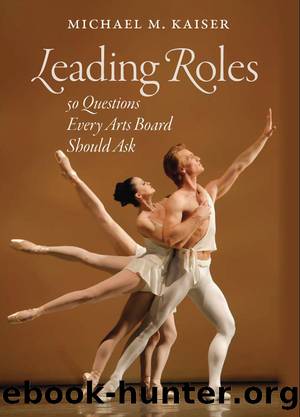Leading Roles by Kaiser Michael M.;

Author:Kaiser, Michael M.;
Language: eng
Format: epub
Publisher: Brandeis University Press
Board and Marketing
26 HOW DO WE EVALUATE A MARKETING PLAN?
While board members are generally far more involved in fundraising than in marketing, it is still essential that board members understand and concur with the marketing plans supporting both earned and unearned income. Arts organizations that do not pursue smart, integrated marketing efforts are doomed to failure, no matter how good the art is. But for many board members, the marketing plan is simply about attractive brochures and a cute logo.
Marketing activities should be divided into two categories: programmatic marketing and institutional marketing. Programmatic marketing is to persuade people to buy tickets. Institutional marketing is to entice audience members and donors to support the institution.
Programmatic marketing is the central focus of most arts organizations, whose marketing departments thus devote almost all their time and resources to this effort. The prevalent but incorrect notion is that the benefits of marketing are limited to ticket sales. In reality, a balanced approach to programmatic and institutional marketing can have as big an impact on fundraising as it does on earned income.
Programmatic marketing plans must be understood by the board, before it can approve a ticket-sales forecast in a budget. In particular, the board should understand the nature of each production and how that affects the choice of marketing techniques. Although many arts organizations have a template for the way they market each production (for example, one direct-mail piece, three print ads, two e-mail blasts, one radio ad), not every event requires the same selection of media or size of marketing budget.
Some programs are easy to sell: when the artists are famous, or the repertory is popular, it is not a challenge to sell many tickets. These programs require only informational marketing, simply announcing the program, the artists, the dates, and the phone number to call for tickets. The marketing budget for these attractions can be small, and simple techniques can be used: posters, e-mail blasts, and maybe a postcard. Sometimes when these programs are announced, the media attention alone is enough to sell all the tickets.
Other projects are far more difficult. When the work is unfamiliar or the performers are unknown, substantial effort and budget must be devoted to filling the house. Potential audience members need substantially more information. They benefit from seeing photographs and video clips of the performance, and learning about the creators of the work and the performers. This type of marketing is called missionary marketing. A good missionary marketing campaign includes a substantial use of public relations activities, web sites, direct-mail pieces, and well-designed e-mail blasts. Posters are usually ineffective to promote a work or artist unknown to ticket buyers, since posters do not offer enough of the information necessary for people to make a buying decision.
While board members do not need to know the details of every programmatic marketing campaign, they do need to know that the staff has correctly evaluated the programs in the season and designed a marketing campaign tailored to each event. The board members must also evaluate the programmatic marketing cost and compare it to the revenue potential.
Download
This site does not store any files on its server. We only index and link to content provided by other sites. Please contact the content providers to delete copyright contents if any and email us, we'll remove relevant links or contents immediately.
The Monuments Men by Robert M. Edsel(1487)
Things Are What You Make of Them: Life Advice for Creatives by Adam J. Kurtz(1454)
The Freelance Manifesto: A Field Guide for the Modern Motion Designer by Joey Korenman(1236)
101 Gag Ideas: Companion to the One Minute Caricature by James van der Keyl(1090)
Find Your Artistic Voice by Lisa Congdon(1061)
Boom by Michael Shnayerson(1026)
The Business of Being an Artist by Daniel Grant(976)
Your Art Will Save Your Life by Beth Pickens(951)
The Lady in Gold by Anne-marie O'connor(945)
Your Inner Critic Is a Big Jerk by Danielle Krysa(938)
Create Your Art Career by Rhonda Schaller(935)
Breakfast at Sotheby's(922)
Seven Days in the Art World by Sarah Thornton(920)
How to Survive and Prosper as an Artist by Caroll Michels(867)
33 Artists in 3 Acts by Sarah Thornton(856)
When Talent Isn't Enough: Business Basics for the Creatively Inclined by Kristen Fischer(840)
Art Held Hostage by John Anderson(831)
Art of the Deal by Noah Horowitz(816)
The Graphic Designer's Guide to Better Business Writing by Barbara Janoff & Ruth Cash-Smith(815)
